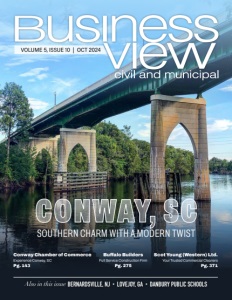Chinook’s Edge School Division
Shaping the Future with Innovation and Community Engagement
From cutting-edge career pathways to adaptive learning models, this leading school Division puts students’ futures first
Chinook’s Edge School Division, located in Central Alberta, serves a broad and diverse student population, from rural communities to more suburban areas. The division has earned a reputation for its focus on high academic standards, engaging with stakeholders, and the well-being of its students. But what truly sets Chinook’s Edge School Division apart is its shared vision—one that prioritizes academic success and the voices of everyone involved, from students to parents, teachers, and staff.
Kurt Sacher, Superintendent of Schools, describes this approach as one of the key pillars of Chinook’s Edge School Division. “Within our school division, some of the core values we’ve promoted revolve around giving voice to all levels of the organization,” he explains. “We have structures in place for students, staff, and parents to communicate effectively, ensuring that as we move forward, everyone has a say in the decisions being made.”
One of the defining characteristics of Chinook’s Edge School Division is understanding the “why” behind its actions. For Sacher, this is not just about following educational trends and it’s about more than meeting provincial standards—it’s about fostering environments where students can thrive. “We’ve really promoted understanding the reasons behind what we do,” he says. “That understanding helps ensure that everyone, from teachers to support staff, feels invested in the outcomes. We’re not just going through the motions. We’re making intentional, thoughtful decisions that affect the lives of our students.”
Strategic Priorities: Academic Excellence, Well-being, and Career Connections
For Chinook’s Edge School Division, long-term success hinges on a well-structured plan that addresses the diverse needs of its students. Sacher precisely outlines its priorities, explaining how the division’s strategy is designed to be focused and flexible.
“We’ve been working on three key goals for years,” he says. “Academic excellence is a key priority, which includes a focus on literacy and numeracy. The second is social-emotional well-being, not just for students but for staff as well. And lastly, career connections. We believe we’re a provincial leader in that area, thanks to the partnerships we’ve developed and the work our staff have done” These core goals are part of what he calls the “education plan,” a comprehensive roadmap that reflects the division’s strategic vision.
A significant part of that plan involves expanding the division’s approach to adaptive learning—something Sacher is passionate about. When asked to elaborate, he explains that adaptive learning is about meeting the varied needs of students who don’t fit the mold of a traditional classroom. “We have students with all kinds of learning needs,” he says. “Take, for example, students who are part of an elite figure skating group, or are on the rodeo circuit, traveling across the United States. They don’t have the time to sit in a traditional classroom. So, we’ve had to get creative—using online tools and other innovative approaches.”

Building a Culture of Teacher Retention
As teacher shortages become a growing concern across North America, Chinook’s Edge School Division takes an intentional approach to recruitment and retention. Sacher is candid about the division’s philosophy regarding staff retention.
“We haven’t utilized incentives like some U.S. locations might,” he notes. “What we’ve prided ourselves on is really trying to make our school environments where a teacher wants to work.” According to him, this environment is built on open communication and a deep understanding of the challenges teachers face. The division’s “Teachers Matter” group is a key part of that process, providing an ongoing platform for educators to voice their concerns and ideas. “We listen to them on an ongoing basis and try to respond as an organization to some of their difficulties,” he adds.
A cornerstone of Chinook’s Edge School Division’s support system is its robust mentorship program for new teachers. The division offers a two-year mentorship, pairing new hires with experienced educators to guide them through their first years in the classroom. “We’re very proud of that,” Sacher says, emphasizing that this program has been instrumental in helping new teachers feel confident and supported as they navigate the challenges of their profession. This mentorship, combined with reasonable class sizes—a policy the board has consistently maintained over the past decade—creates a working environment where teachers can thrive.
Sacher also highlights the division’s expectations regarding instructional quality. “We expect teachers to be current and progressive, utilizing appropriate assessment practices,” he explains. With Alberta rolling out new curriculum initiatives, the division has made it a priority to provide ample support for its teachers, ensuring they have the tools and resources needed to implement the new content successfully.
High School to Career: Earning College Credits Early
Chinook’s Edge School Division’s dual credit program provides students with exposure to potential careers while actively accelerating their progress toward them. Holly Bilton is the Board Chair, and her expertise shines through as she discusses its leadership in dual credit programs.
“In full transparency, I manage school engagement for CAREERS, so this is something I’m deeply familiar with,” she says, pointing out that Chinook’s Edge School Division is second only to the much larger Calgary Board of Education in the number of dual credit offerings.
The scope of Chinook’s Edge School Division’s dual credit program is extensive, covering both trades and academic fields. “We offer courses in trades like welding, heavy equipment, carpentry, and industrial mechanics,” she explains. “We also have dual credit partnerships in areas like veterinary technology, horticulture, hospitality, and even aviation. Students can complete their ground school for aviation while still in high school, giving them a head start if they choose to pursue a career as a pilot.”
Bilton outlines how the dual credit programs offer tangible benefits, particularly in trades. “In many of our trades, which are significantly needed across the country, students complete their first year through pre-employment classes,” she explains. By the time they graduate high school, these students have already written their first-year apprenticeship exam and are considered second-year apprentices. The program is bolstered by the Registered Apprenticeship Program (RAP) credit, which allows students to gain the necessary hours for their apprenticeship while still in school.
The Power of Career Pathways: The Collegiate Project
In Chinook’s Edge School Division, career readiness is about more than just preparing students for the workforce—it’s about igniting their motivation for learning by connecting them to tangible futures. The Collegiate Project, one of the division’s most influential partnerships, embodies this approach, offering students a unique opportunity to bridge the gap between high school and post-secondary education.
Sacher views this project as a game-changer for student success. “If students have a link into the future, it drives motivation inside the school setting,” he explains. “Think of it as having one foot in K-12 and one foot in post-secondary—when students are connected in that way, we see incredible results.” The data backs this up: the division’s graduation rate soars to 98% for students involved in career engaging pathways, compared to the typical rate of around 83%. “We’re quite proud of that,” he says, emphasizing how the program has transformed outcomes for many students.
At the heart of the Collegiate Project is a collaboration between Chinook’s Edge School Division, two Red Deer school divisions, Wolf Creek Public Schools, Olds College, Red Deer Polytechnic, and the nonprofit CAREERS. These partnerships provide students with career-oriented learning while creating opportunities for government engagement through students participating in panels with the Premier of Alberta to share their experiences.
Investing in Infrastructure: Expanding Opportunities for Students
Chinook’s Edge School Division understands that creating meaningful educational experiences requires developing the right infrastructure. Bilton provides insight into the division’s infrastructure strategy, highlighting recent investments at Olds College and Red Deer Polytechnic.
“The funds we were given helped build more opportunities on those campuses so that our students can come together and do labs and learn with the college instructors,” she says. These expanded facilities allow high school students to experience college-level coursework while still enrolled in secondary school, a key part of the division’s career-focused education model.
The next major project on the horizon is a new high school in Sylvan Lake. “This is the number one priority in our capital plan right now,” Bilton says, explaining that the project will feature a joint campus shared with Red Deer Catholic Schools. The goal is to address the growing student population and continue integrating post-secondary opportunities into the high school experience. “We hope to secure funding to add collegiate spaces to the Sylvan Lake campus,” she adds, noting that the location would provide students west of Sylvan with easier access to post-secondary courses without needing to travel to Red Deer.
Sacher also discusses expanding facilities in critical areas and mentions another significant infrastructure project currently underway. “We’re in the middle of construction on Penhold Waskasoo Middle School, and we hope it will be up and running within a year,” he shares.

Partnerships That Power Career-Ready Learning
Chinook’s Edge School Division’s career-focused education model thrives on partnerships that extend far beyond the classroom. The division has built strong relationships with local businesses, post-secondary institutions, and industry leaders, all working together to provide students with meaningful, hands-on learning opportunities.
Bilton emphasizes the importance of these collaborations in creating opportunities for students. “When we think about business partnerships, the list is long,” she says, noting that these connections are often facilitated through the division’s partnership with CAREERS.
This nonprofit helps connect students with industries that are eager to take on apprentices, interns, or co-op students. “Students get to work in integrated learning environments, sometimes even before they finish their dual credit,” Bilton explains. These partnerships allow students to gain real-world experience during the summer, throughout the school year, or in structured internships, depending on the needs of both the students and the businesses.
The geographic diversity of Chinook’s Edge School Division further enhances these opportunities. “We have approximately 13 communities that we work within Red Deer County and Mountain View County,” Bilton points out. Despite the rural nature of many of these areas, the smaller community sizes offer a distinct advantage. “The communities really know the students,” she adds. “They want them participating in their businesses, they want them to grow, and they want them to stay in these communities and make them vibrant for the long term.”
Excellence in Sports and the Arts
While academics are a central focus at Chinook’s Edge School Division, students have equally robust opportunities to excel in sports and the arts. Sacher explains that the division takes pride in its competitive athletic programs, all of which are coordinated under the Alberta School Athletic Association (ASAA).
“We’re very competitive in all of our communities relative to the typical high school sports opportunities,” he says, pointing out that each school in the division participates in ASAA-sanctioned events. But the sports offerings go beyond traditional teams. “At Fox Run Middle in Sylvan Lake, we have a hockey academy built right into the school for middle school students,” Sacher notes. This program is designed to allow young athletes to integrate their academic and athletic pursuits from an early age.
Beyond sports, the division’s support of music and the arts is equally notable. Sacher highlights Didsbury’s standout band program, which has gained national recognition thanks to the exceptional leadership of its retiring band director. “Whatever award is available for a band teacher, I think he’s received it,” Sacher says, reflecting on the lasting impact the program has had on the community.
The division also sees its academies as a way to blend creativity with practical skills. At Hugh Sutherland School in Carstairs, for example, a STEAM academy focuses on integrating science, technology, engineering, arts, and math in a hands-on learning environment. “It’s one of our largest schools in the division, serving students from Grades 5 to 12,” Sacher points out.
Future-Focused Goals: Preparing for the Next 18 Months
As Chinook’s Edge School Division looks toward the future, Sacher outlines three primary objectives that will guide the division through the next 18 months. “Number one is our careers approach,” he says, referencing the division’s groundbreaking work with Career Pathways and the collegiate project.
“We’re on the cutting edge of what’s possible there, and we want to take it to an even higher level.” As one of the division’s flagship initiatives, Career Pathways has already transformed how students prepare for their future. However, Sacher and his team are determined to push it further—integrating more opportunities for students to engage with real-world career experiences while still in school.
The second objective, Sacher continues, is a bold initiative to address students’ growing social and emotional needs. “We are putting in an additional staff member in all of our schools with 200 or more students to help support and guide students with complex needs,” he explains. This move reflects the division’s proactive approach to mental health, acknowledging that students require more than academic resources to thrive. By expanding its team of staff, Chinook’s Edge School Division is doubling down on supporting holistic student well-being—ensuring that all students, regardless of their challenges, have the guidance they need.
Finally, adaptive learning remains a cornerstone of the division’s strategy for the future. “I think you’ll see us take adaptive learning to another level,” Sacher says, referring to the division’s work in creating personalized learning environments for students with a wide range of needs. Whether through innovative technology or more flexible instructional models, Chinook’s Edge School Division continues to invest in solutions that meet students where they are—providing them with the tools to succeed in an increasingly complex world.
AT A GLANCE
Chinook’s Edge School Division
What: K-12 public school division focused on innovative education and career pathways
Where: Central Alberta, Canada
Website: https://www.cesd73.ca/
PREFERRED VENDORS
Alberta School Employee Benefit Plan (ASEBP) – https://www.asebp.ca/
The Alberta School Employee Benefit Plan is an employee life and health trust providing comprehensive benefits to Alberta’s publicly funded K-12 education sector. Coverage includes extended health, dental, vision, life insurance, and disability support. ASEBP also offers health and wellness spending accounts, an Employee and Family Assistance Program, and continued retiree benefits through the MyRetiree Plan.




